ingredients
The key to any healthy diet is eating real, whole foods. For your 30-day keto cleanse, you’ll want to seek out certain ingredients and avoid others.
fats
On a keto diet, you need lots of healthy fat to burn as fuel. But as important as it is to seek out healthy fats, it’s just as important to avoid unhealthy fats.
healthy fats

Fats with high amounts of saturated fatty acids (SFAs)—such as MCT oil, coconut oil, tallow, and lard—are best: they are stable and anti-inflammatory, protect against oxidation, and have many other important health benefits. Look for grass-fed and organic sources; these are always best. Try to avoid polyunsaturated fatty acids (PUFAs): they are prone to oxidation and are therefore less healthy. (We’ll talk more about unhealthy fats on
see here
.)
On the facing page is a list of the best oils and fats to use, with their SFA and PUFA content. When you see “Paleo fat” mentioned in a recipe in this book, it’s fine to use any of these fats—just make sure to take into account whether you need it for a hot or a cold use.
MCT oil
MCT stands for “medium-chain triglycerides,” which are chains of fatty acids. MCTs are found naturally in coconut oil, palm oil, and dairy, and they’re particularly helpful on a keto diet because the body uses them quickly and any MCTs not immediately utilized by the body are converted to ketones.
MCT oil is extracted from coconut or palm oil and contains a higher, concentrated level of MCTs, so it’s great for adding ketones to your diet. Whenever MCT oil appears in a recipe in this book, it’s always my first choice, but to make the recipes as accessible as possible, I’ve provided alternative oil choices as well.

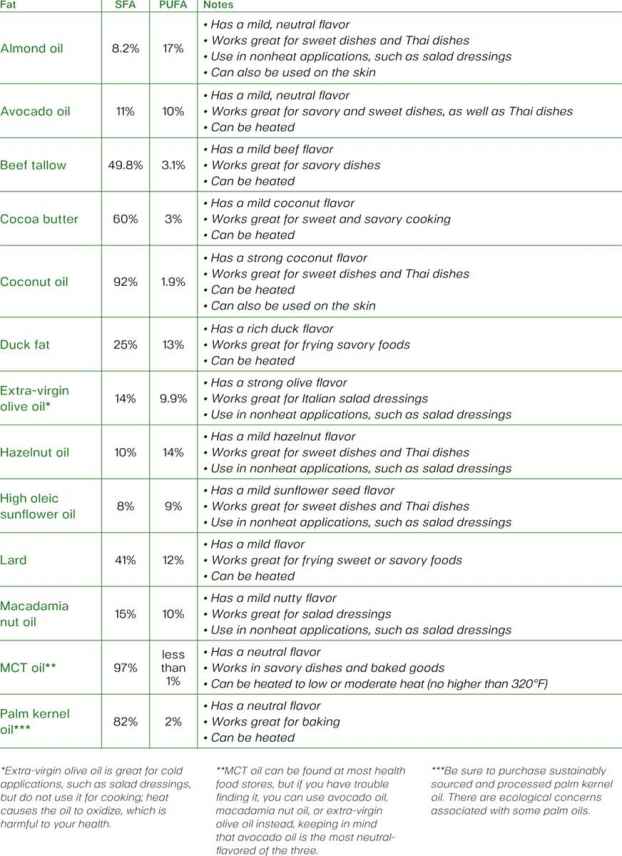
On the 30-day cleanse, I recommend avoiding all dairy—it’s not included in any of the recipes in this book. Omitting dairy entirely for those thirty days gives the gut a chance to heal from any irritation or inflammation dairy may have caused.
If at the end of the cleanse you want to try adding dairy back to your diet, choose just one item and see how your body responds to it over two or three days. If you don’t have any reaction, chances are you’re not dairy sensitive.
If you’re not dairy sensitive, the following are great healthy, keto-friendly dairy fats to add to your diet:
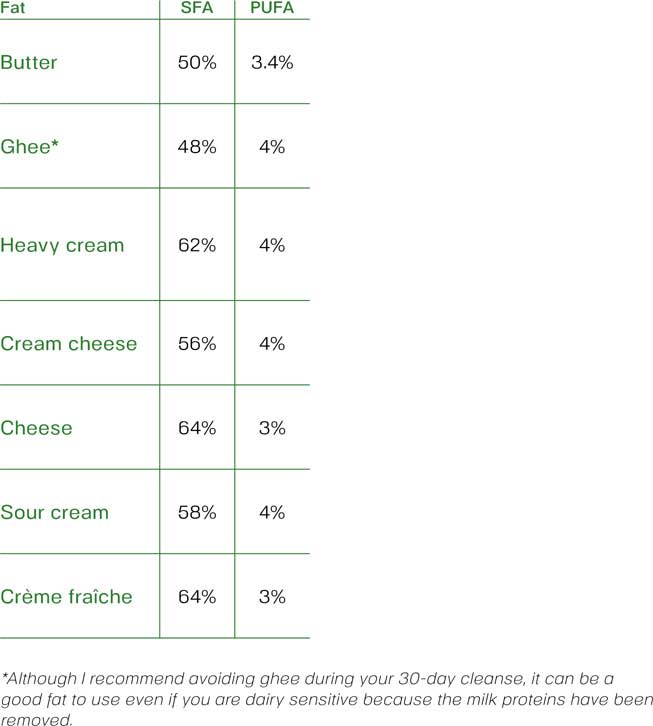
purchasing keto-friendly ingredients
You can purchase keto-friendly pantry products on my website,
MariaMindBodyHealth.com/store
. They’re also available in most grocery stores.
To save money, I recommend buying ingredients in bulk—including perishables like meat and fresh veggies. They can be frozen (a chest freezer is a great investment) and thawed later.
Remember, choosing the best-quality organic foods is always optimal.
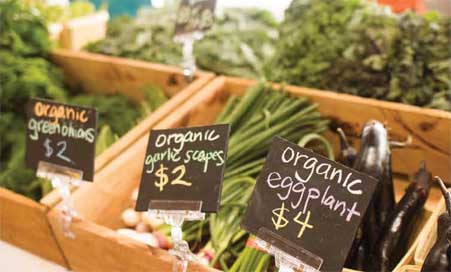
bad fats

Two kinds of fats should be avoided on a ketogenic diet: trans fats and polyunsaturated fatty acids (PUFAs).
Trans fats are the most inflammatory fats; in fact, they are among the worst substances for our health that we can consume. Many studies have shown that eating foods containing trans fats increases the risk of heart disease and cancer.
Here is a list of trans fats to avoid at all costs:
· Hydrogenated or partially hydrogenated oils (check ingredient labels)
· Margarine
· Vegetable shortening
PUFAs should also be limited, as they are prone to oxidation. Many cooking oils are high in PUFAs. At right is a list of the most common ones.
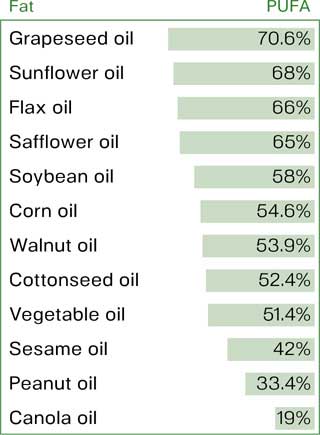
proteins

It’s always best to choose grass-fed, humanely raised meat and wild-caught seafood. Not only do they offer more nutrients, but they also haven’t been exposed to added hormones, antibiotics, or other potential toxins. (For help choosing sustainably sourced seafood, check out the Monterey Bay Aquarium Seafood Watch app and website, seafoodwatch.org.)
WILD MEATS
• Bear
• Boar
• Buffalo
• Elk
• Rabbit
• Venison
BEEF
GOAT
LAMB
PORK
FISH
• Ahi/mahi mahi
• Catfish
• Halibut
• Herring
• Mackerel
• Salmon
• Sardines
• Snapper
• Swordfish
• Trout
• Tuna
• Walleye
• White fish (cod, bluegill)
SEAFOOD/SHELLFISH
• Clams
• Crab
• Lobster
• Mussels
• Oysters
• Prawns
• Scallops
• Shrimp
• Snails
POULTRY
• Chicken liver
• Duck
• Game hens
• Goose
• Ostrich
• Partridge
• Pheasant
• Quail
• Squab
• Turkey
EGGS
• Chicken eggs
• Duck eggs
• Goose eggs
• Ostrich eggs
• Quail eggs

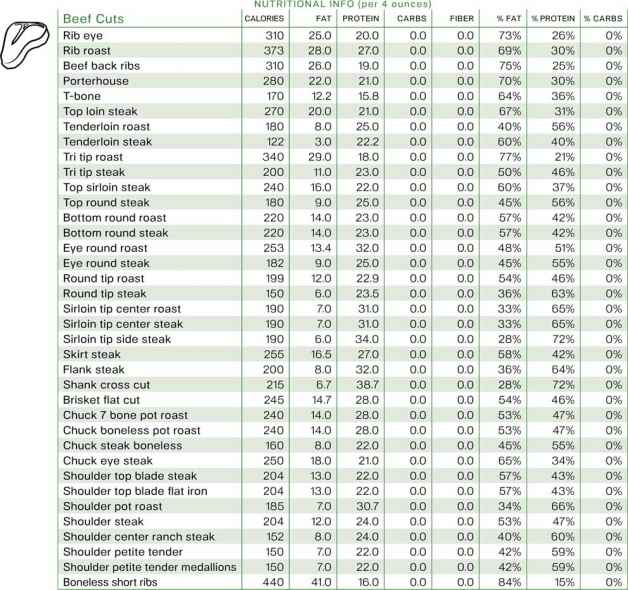


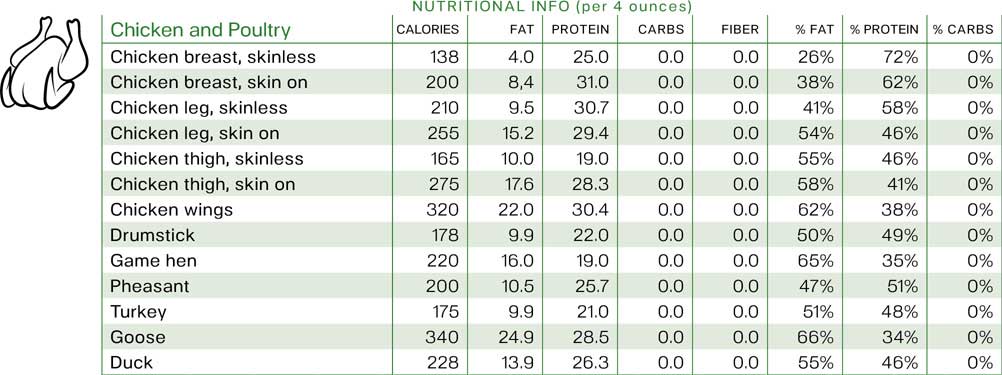

picking the best-quality eggs
Eggs are an amazingly nutritious food, especially the yolks, which are full of choline, healthy fats, and a ton of flavor. And high-quality eggs—those from healthy, humanely raised hens—are even more nourishing and tastier. So which eggs are the best quality?
Brown or White Eggs:
There’s absolutely no difference in quality here; the only thing that determines the color of an egg is the breed of the hen. Do not choose eggs based on color.
Egg Grades:
Eggs can be AA, A, or B. There is little to no difference in the taste, though, and no difference in nutritional value. Grade AA eggs have the thickest, firmest whites and high, round yolks. This grade of egg is virtually free of defects and is best for frying, poaching, or methods where presentation is important. Grade A eggs are the same quality as grade AA, but the white is categorized as “reasonably” firm. Most grade B eggs are sold to restaurants, bakeries, and other food institutions and are used to make liquid, frozen, and dried egg products.
Vegetarian-Fed:
The only thing this label means is that the hens are fed a diet based on corn (which is usually genetically modified). In order to ensure the hens only consume a vegetarian diet, they are kept in cages. But chickens are naturally omnivores: they evolved to eat insects, worms, and grubs as well as grass and grains. They weren’t meant to be vegetarians!
Certified Organic:
This label means that the hens are not in cages but in barns. They are required to have access to the sun, but that does not necessarily mean they can go outside; there may be a small window in the barn for sunlight. The hens are fed an organic, vegetarian diet that is free from antibiotics and pesticides. This label is regulated with inspections.
Free-Range or Cage-Free:
This sounds like a good choice, right? Well, all this really means is that the hens are not caged. There is no requirement to let the hens outside, there are no mandatory inspections to regulate this claim, and there are no guidelines for what the birds are fed.
Omega-3 Enriched:
This label indicates that the hens’ feed has extra omega-3 fatty acids added to it in the form of flaxseed. But eggs already are a good source of omega-3s, so there’s no need to seek out eggs with this label.
Since most of the labels used on egg cartons don’t really help us figure out which eggs are healthiest, here are some guidelines to follow when egg shopping:
1.
Be conscious of antibiotic and hormone use. While the USDA prohibits the use of hormones for egg production and the use of therapeutic antibiotics is illegal unless hens are ill, these rules aren’t always enforced. The only way to ensure that the hens were antibiotic-free is to purchase organic eggs.
2.
To guarantee that you eat truly free-range eggs, purchase eggs from pastured hens. Pastured hens are able to eat their natural diet of greens, seeds, worms, and bugs, and studies show that eggs from pastured hens may contain more omega-3 fatty acids, vitamins, and minerals.
3.
Smaller eggs tend to have thicker shells than large eggs and are less likely to become contaminated by bacteria.
4.
Be cautious of unregulated labels. Terms like “natural” and “cage-free” are often used in labeling, but these claims may not necessarily be true. Claims on eggs with the USDA shield have been verified by the Department of Agriculture, so always look for the shield when you purchase eggs from a store.
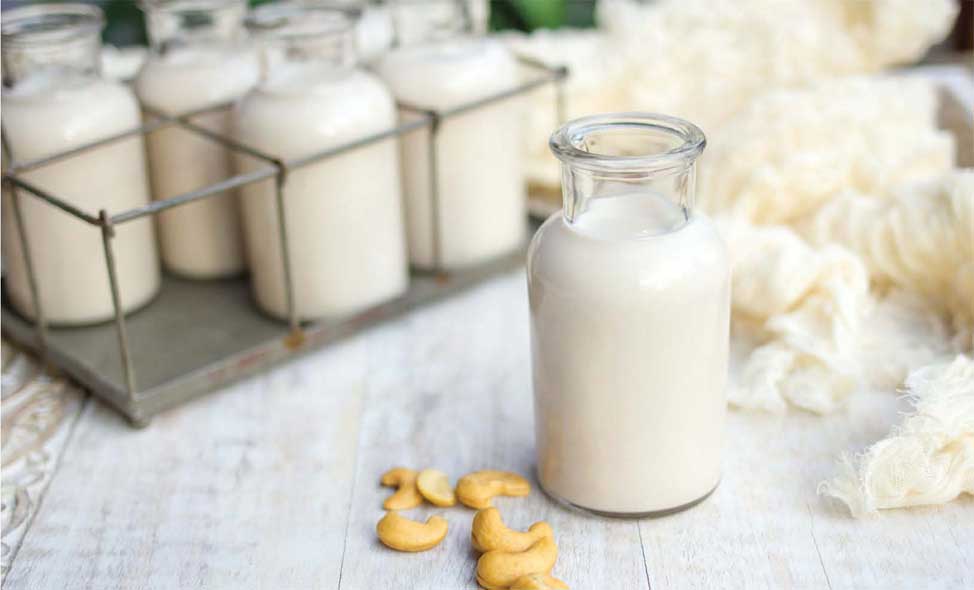
liquids

It probably goes without saying that sodas and fruit juices should be avoided during your keto cleanse—they’re full of sugars that will raise your blood sugar and kick you out of ketosis. But that doesn’t mean you’re limited to just water! The following are all liquids you can consume during your cleanse.
• Unsweetened almond milk
• Unsweetened cashew milk
• Unsweetened coconut milk
• Unsweetened hemp milk
• Green tea
• Organic decaf caffè Americano (espresso with water)
• Mineral water
• Water (reverse osmosis is best)
nuts and seeds

Some nuts and seeds are fine on a keto diet, but they can take some people with metabolic syndrome out of ketosis. For that reason, I do not recommend that you consume nuts and seeds during your 30-day cleanse, and I do not use them in the recipes in this book.
veggies

Fresh vegetables are packed with nutrients and are an important part of a keto cleanse, but to make sure you stay in ketosis, it’s important to choose nonstarchy vegetables, which are lower in carbs. The following are some of the nonstarchy vegetables that I use most.
• Arugula
• Asparagus
• Bok choy
• Broccoli
• Cabbage
• Cauliflower
• Celery
• Collard greens
• Cucumber
• Endive
• Garlic
• Kale
• Kelp
• Lettuce: red leaf, Boston, romaine, radicchio
• Mushrooms
• Onions: green, yellow, white, red
• Peppers: bell peppers, jalapeños, chiles
• Seaweed
• Swiss chard
• Watercress
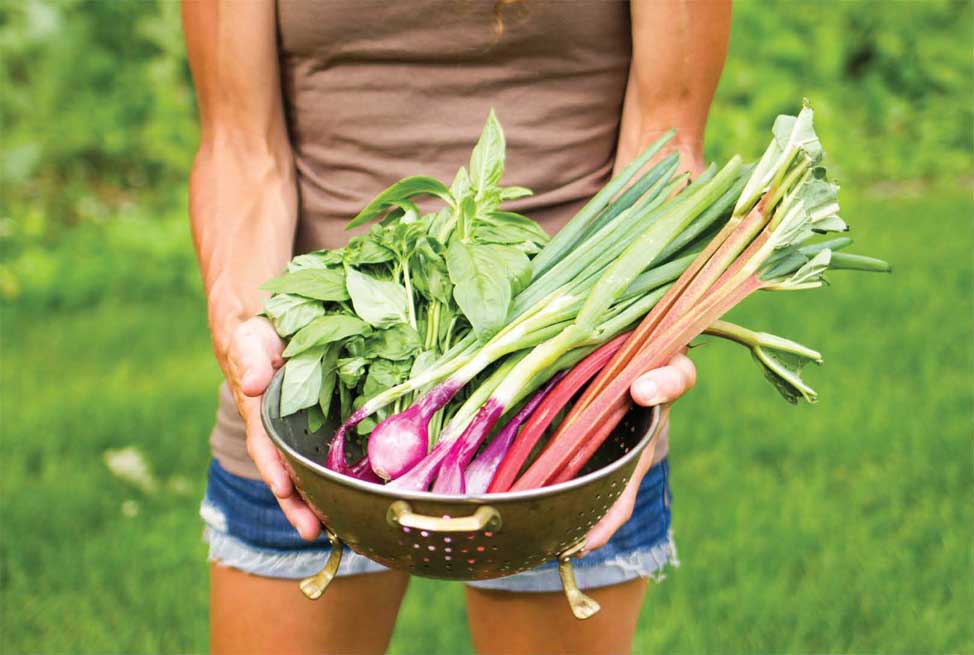
herbs and spices

Spices and fresh herbs are the most nutritious plants you can consume. For example, everyone thinks spinach is an amazingly nutritious food, but fresh oregano has eight times its amount of antioxidants! Sure, we don’t eat a cup of oregano, but it does go to show that a little bit of an herb provides a huge benefit.
• Anise
• Annatto
• Basil
• Bay leaf
• Black pepper
• Caraway
• Cardamom
• Cayenne pepper
• Celery seed
• Chervil
• Chili pepper
• Chives
• Cilantro
• Cinnamon
• Cloves
• Coriander
• Cumin
• Curry
• Dill
• Fenugreek
• Galangal
• Garlic
• Ginger
• Lemongrass
• Licorice
• Mace
• Marjoram
• Mint
• Mustard seeds
• Oregano
• Paprika
• Parsley
• Peppermint
• Rosemary
• Saffron
• Sage
• Spearmint
• Star anise
• Tarragon
• Thyme
• Turmeric
• Vanilla beans
fruit

We tend to think of fruit as a health food, but in reality, most fruits are full of carbs and sugar. In fact, studies prove that the produce we consume today is lower in nutrients and much higher in sugar than it was in Paleolithic times. In general, high-sugar fruits like grapes, bananas, and mangoes should be avoided during your keto cleanse.
But that doesn’t mean you have to avoid all fruits! I once made a keto fruit salad filled with cucumbers, olives, eggplant, and capers, all covered in a Greek vinaigrette. So yes, fruits are certainly allowed. Just seek out those that are low in sugar.
• Avocados
• Cucumbers
• Eggplants
• Lemons
• Limes
• Olives
• Seasonal wild berries (in moderation)
• Tomatoes
the pantry
In addition to the whole foods discussed in the previous pages, some pantry items are essential for making the recipes in this book.
baking products

See here
for recommended sweeteners.
• Baking soda
• Blanched almond flour
• Cocoa butter
• Coconut flour
• Egg white protein powder (check carbs and added ingredients—I recommend Jay Robb brand)
• Extracts and essential oils, including pure vanilla extract, for flavoring
• Pecan meal
• Unsweetened baking chocolate
• Unsweetened cocoa powder
• Whey protein powder (check carbs and added ingredients; do not use if dairy sensitive)
• Xanthan gum and guar gum
sauces and flavor enhancers

• Coconut aminos
• Coconut vinegar
• Fish sauce
 egg replacer
egg replacer
The only keto egg replacer that I recommend is gelatin. Chia and flax seeds are not recommended because of their estrogenic properties as well as their high total carb count.
canned and jarred pantry foods

It is always better to buy fresh, but here are some keto-friendly foods that are also great jarred or canned:
• Banana peppers
• Bell peppers
• Boxed beef and chicken broth
• Canned coconut milk
• Canned salmon
• Canned tuna
• Capers
• EPIC bars (made from grass-fed meat—but check for added sugars)
• Fermented pickles
*
• Fermented sauerkraut
*
• Mikey’s English Muffins
• Nori wraps
• Olives (choose jar over can)
• Organic dried spices
• Paleo mayo
• Pickled eggs
• Pickled herring
• Pizza sauce (check for oils and added sugar)
• Pure Wraps
• Quality marinara sauce (check for oils and added sugar)
**
• Sardines
• Tomato paste
**
• Tomato sauce
**
*
Not only is fermenting a great way to preserve food, but it also creates beneficial gut bacteria and helpful digestive enzymes. Fermented sauerkraut is particularly rich in B vitamins.
**
Make sure to buy jarred, not canned, tomato products. The lining of cans contains BPA, a chemical that’s associated with several health problems and may affect children’s development, and tomatoes’ high acidity can cause more BPA to leach into the food.
natural sweeteners

In my recipes, I always use natural sweeteners. Just as sugarcane and honey are found in nature, so are erythritol and the stevia herb.
However, I prefer not to use sweeteners such as honey, maple syrup, and agave in my recipes because, even though they’re natural, they raise blood sugar, which not only causes inflammation but will also take you out of ketosis. (A list of where common sweeteners fall on the glycemic index is at right.)
Fructose is particularly problematic. More than glucose, it promotes a chemical reaction called glycation, which results in advanced glycation end products (AGEs). AGEs form a sort of crust around cells that has been linked with a wide range of diseases, from diabetes and heart disease to asthma, polycystic ovary syndrome, and Alzheimer’s. Fructose also contributes to nonalcoholic fatty liver disease. For these reasons, I avoid sweeteners high in fructose: table sugar, high-fructose corn syrup, honey, agave, and fruit.
The following is a list of the natural sweeteners that I recommend, all of which have little effect on blood sugar. I’ll talk in more detail about each below.
• Erythritol, such as Sukrin brand
• Swerve brand sweetener
• Stevia, liquid or powdered (with no additives)
• Stevia glycerite (thick liquid stevia)
• Monk fruit
• Xylitol
• Yacón syrup
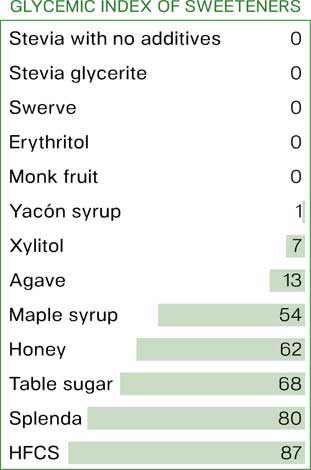
erythritol
Despite its chemical-sounding name, erythritol is not an artificial sweetener. It’s a sugar alcohol that is found naturally in some fruits and fermented foods. Erythritol is a calorie-free sweetener that doesn’t raise blood sugar or insulin, and because it’s almost completely absorbed before it reaches the colon, it doesn’t cause digestive upset the way other sugar alcohols can.
Erythritol is generally available in granulated form, though sometimes you can find it powdered. If you purchase granulated erythritol, I recommend grinding it to a powder before using. In its granulated form, erythritol doesn’t dissolve well and can give dishes a grainy texture.
monk fruit
Also known as lo han kuo, monk fruit is cultivated in the mountains of southern China. Similar to stevia, it’s 300 times sweeter than sugar, but unlike stevia, it doesn’t have a bitter aftertaste. Monk fruit comes in pure liquid form and in powdered form.
Since it is so much sweeter than sugar, the powdered form of monk fruit is typically bulked up with another sweetener so that it measures cup for cup like sugar. Check the ingredients for things like maltodextrin and only buy brands that use keto-friendly sweeteners, such as erythritol.
stevia
Stevia is available as a powder or a liquid. Because stevia is so concentrated, many companies add bulking agents like maltodextrin to powdered stevia so that it’s easier to bake with. Stay away from those products. Table sugar has a glycemic index of 52, whereas maltodextrin has a glycemic index of 110!
Look for products that contain just stevia or stevia combined with another natural and keto-friendly sweetener.
stevia glycerite
Stevia glycerite is a thick liquid form of stevia that is similar in consistency to honey. Do not confuse it with liquid stevia, which is much more concentrated. Stevia glycerite is about twice as sweet as sugar, making it a bit less sweet than pure liquid or powdered stevia. I prefer to use stevia glycerite because, unlike the powdered or liquid forms of stevia, it has no bitter aftertaste.
Stevia glycerite is great for cooking because it maintains flavor that many other sweeteners lose when heated. However, it doesn’t caramelize or create bulk, so most baking recipes call for combining it with another sweetener.
swerve brand sweetener
Swerve is zero-calorie brand of sweetener that combines erythritol (
see here
) and oligosaccharides, which are prebiotic fibers found in starchy root vegetables. Swerve is nonglycemic and therefore does not affect blood sugar. It also measures cup for cup just like table sugar.
I use the powdered form of Swerve (the one labeled “confectioners”) because it dissolves particularly well when cooking or baking. Swerve even browns and caramelizes like sugar.
xylitol
Xylitol is a naturally occurring low-calorie sweetener found in fruits and vegetables. It has a minimal effect on blood sugar and insulin. While it’s not as low on the glycemic index as erythritol, erythritol doesn’t work well for low-carb hard candies (it doesn’t melt properly), so I use xylitol instead.
Xylitol has been known to kick some people out of ketosis, so if you’re using it for baking or cooking, monitor your ketones closely and stop using it if you find that you’re no longer in ketosis.
yacón syrup
Yacón syrup is a thick syrup that is pressed from the yacón root and tastes a bit like molasses. It has been consumed for centuries in Peru.
I use yacón syrup sparingly, both because it is very expensive and because it has some fructose in it. A small jar lasts us four to six months. I use a tablespoon here and there to improve the texture and flavor of my sauces; it’s ideal for giving sweet-and-sour sauce that perfect mouthfeel or giving BBQ sauce a hint of molasses. Using these small amounts keeps the sugar to 1 gram or so per serving.
using sweeteners in the recipes in this book
If you’re trying keto for the first time on your 30-day keto cleanse, the recipes in this book should have just the right amount of sweetness. But if you continue on with the ketogenic lifestyle, you may find that food naturally begins to taste sweeter, and you may want to reduce the amount of sweetener used in a recipe.
Whenever a recipe requires a powdered sweetener, my go-to choice is the natural sugar replacement called Swerve, which is available in granular and powdered form. I always use the powdered (confectioners’) form of Swerve because it gives you a smoother finished product and better overall results. That said, you can always pulverize a granular form of erythritol or Swerve in a blender or coffee grinder to get the powdered texture.
If a specific sweetener or type of sweetener (such as powdered or liquid) is called for, do not substitute any other sweetener; these recipes rely on these particular sweeteners. For example, in recipes where the sweetener has to melt, some sweeteners won’t work, so it’s important to use exactly what’s called for.
If a sweetener in an ingredients list is followed by “or equivalent,” such as “¼ cup Swerve confectioners’-style sweetener or equivalent amount of liquid or powdered sweetener,” you are free to use any keto-friendly sweetener, liquid or powdered. For example, you could use liquid stevia, stevia glycerite, monk fruit, or xylitol.
I’ve used Swerve, my favorite keto-friendly sweetener, in many of the recipes in this book. But if you prefer to use another keto-friendly sweetener, here are the conversion ratios:
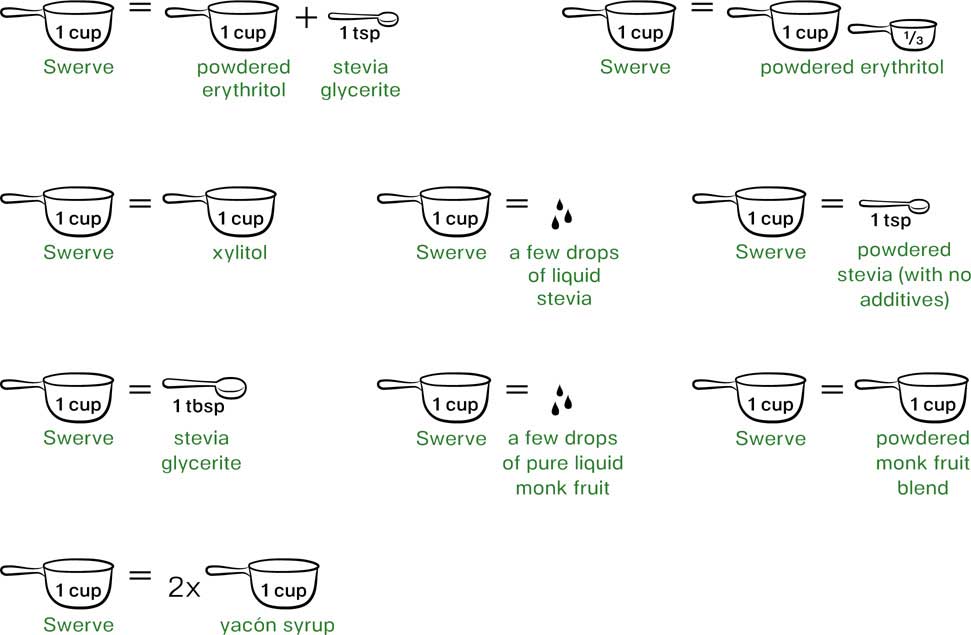
sweeteners to avoid
honey
Honey may be less refined than table sugar, but it is still high in calories and fructose. One teaspoon of honey contains 22 calories—more than one teaspoon of sugar, which has 16. The biggest problem with honey, however, is that it is roughly 50 percent fructose (
see here
for more on fructose).
agave
Don’t be fooled when you see that agave is low on the glycemic index—it’s about 90 percent fructose. That makes it a very unhealthy choice (
see here
for more on the problems with fructose).
coconut sugar
Even though I see claims all over the Web that coconut sugar is commendably fructose-free, 70 to 80 percent of it is made of sucrose, which is half fructose (and half glucose). This essentially means that, gram for gram, coconut sugar has the same amount of fructose as table sugar.
sucralose (splenda)
Sucralose, also known as Splenda, is a popular artificial sweetener. Liquid sucralose is so concentrated that you need very small amounts to achieve the desired sweetness. Splenda, however, is bulked up so it can be used in place of table sugar. The first two ingredients in Splenda are dextrose and maltodextrin, which are carbohydrates that are not free of calories. One cup of Splenda contains 96 calories and 32 grams of carbohydrates, which is substantial, especially for those with diabetes.
Even more troubling, sucralose has been found to inhibit the absorption of zinc and iodine, which are essential for proper thyroid function. It is also linked to a decrease in the beneficial bacteria in the gut, which can cause numerous health problems.
artificial sweeteners
Artificial sweeteners, such as aspartame, acesulfame potassium, neotame, saccharin, sucralose, and advantame, are not good for your health. They reduce the liver’s ability to filter out toxins, stress your metabolism, and upset the balance of bacteria in the gut, which is essential for proper immune function. Stay away from all artificial sweeteners.
other high-sugar sweeteners
Sugar is often hidden in foods, so read the labels! Check for anything ending in “-ose,” which indicates a sugar, and for the following: agave nectar, beet sugar, brown rice syrup, brown sugar, cane crystals, corn sweetener, corn syrup, corn syrup solids, dehydrated cane juice, dextrin, dextrose, fructose, fruit juice concentrate, glucose, high-fructose corn syrup, honey, invert sugar, lactose, maltose, malt syrup, maple syrup, molasses, palm sugar, raw sugar, saccharose, sorghum, sorghum syrup, sucrose, syrup, treacle, turbinado sugar, and xylose.
undesirable sugar alcohols
Although some sugar alcohols, like erythritol, are great keto-friendly sweeteners, others are not keto-friendly at all. Stay away from maltitol and sorbitol, which raise blood sugar and can cause gastrointestinal issues.
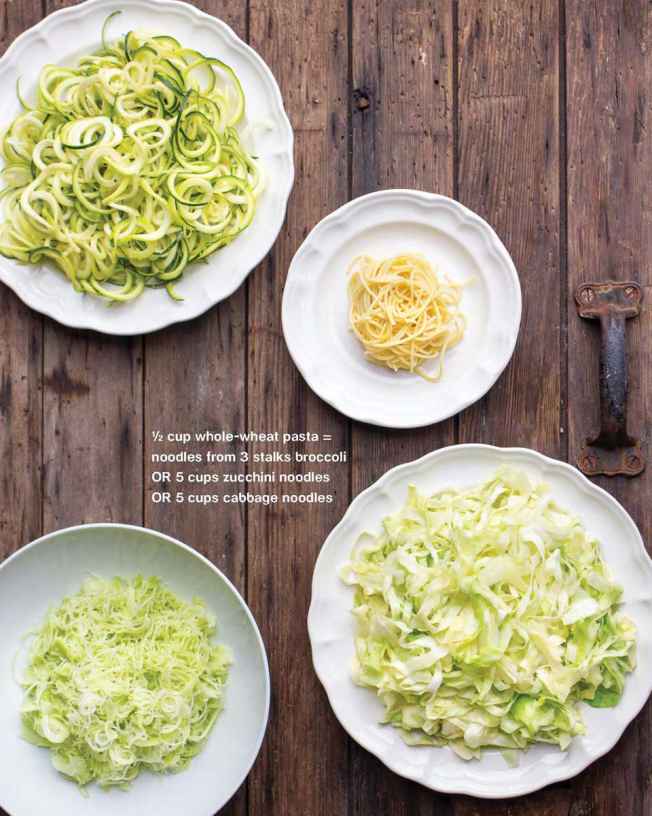
substitutions for pasta
I was that girl who could never stop at ½ cup of pasta, so I loved putting together this comparison of pasta and healthier vegetable-based replacements. All the foods in this photo have the same amount of carbs, so it’s shockingly clear just how much healthier the keto replacements are. As Craig and I prepped the ingredients to photograph, he had to keep making more and more zucchini noodles just to equal the carbs in one measly ½ cup of whole-wheat pasta!




























